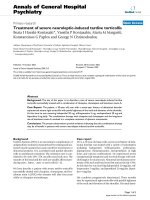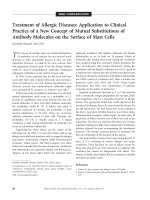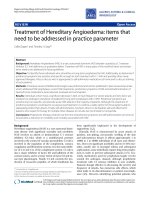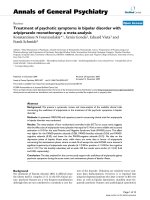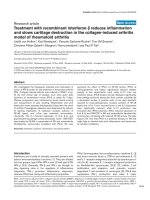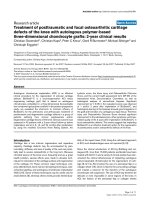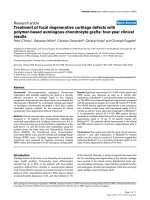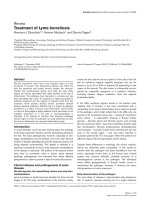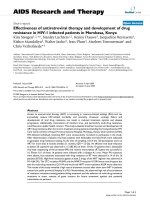Báo cáo y học: "Treatment of stasis dermatitis using aminaphtone: Development of Buffalo Hump in the course of antiretroviral therapy including raltegravir and unboosted atazanavir: a case report and review of the literature" pot
Bạn đang xem bản rút gọn của tài liệu. Xem và tải ngay bản đầy đủ của tài liệu tại đây (287.65 KB, 4 trang )
CAS E REP O R T Open Access
Development of Buffalo Hump in the course of
antiretroviral therapy including raltegravir and
unboosted atazanavir: a case report and review
of the literature
Giancarlo Ceccarelli
1*
, Gabriella d’Ettorre
1
, Francesco Marchetti
2
, Cecilia Rizza
1
, Claudio M Mastroianni
1
,
Bruno Carlesimo
2
, Vincenzo Vullo
1
Abstract
Introduction: The availability of raltegravir plus atazanavir provides an alternative antiretroviral strategy that may
be equally efficacious and less toxic than those currently recommended in HIV treatment guidelines. In fact, this
new combination antiretroviral therapy attracts the attention of the scientific community because both drugs have
a good safety profile coupled with potent antiviral activity, and their combined use would avert nucleoside- and
ritonavir-related toxicities.
Case presentation: We describe the case of a 47-year-old, Caucasian woman treated for HIV-1 infection who
developed Buffalo Hump during antiretroviral therapy, including raltegravir and unboosted atazanavir. Clinical
evaluation and an ultrasonography scan of the cervical region showed a new progressive increase of
lipohypertrophy and the results of DEXA confirmed these data. In our patient the worsening of the Buffalo Hump
cannot be attributed to hypercortisolism; insulin-resistance, diabetes, dyslipidemia, hyperlactatemia and metabolic
syndrome were not present. Moreover, she was not in therapy with antiretroviral drugs that are described as the
cause of Buffalo Hump; on the other hand she developed this side effect three months after the switch of the
antiretroviral therapy to raltegravir plus unboosted ataza navir.
Conclusion: Current data indicate that the etiology of HIV-associated Buffalo Hump remains elusive but is likely
multifactorial; a possible contributing cause, but not the main cause, could be exposure to antiretroviral drugs. To
the best of our knowledge, this is the first report on development of Buffalo Hump in the course of antiretroviral
therapy, including the use of these drugs. On the basis of our data we can formulate the hypothesis of a
pharmacological pathogenesis that underlies the development of this case of Buffalo Hump in the absence of
other risk factors.
Introduction
Antiretroviral (ARV) treatment guidelines currently
recommend ARV regimens containing a Nucleos(t)ide
Reverse Transcriptase Inhibitors (N(t)RTIs) based back-
bone with a Non Nucleoside Reverse Transcriptase Inhi-
bitor (NNRTI) or ritonavir boosted Protease Inhibitor
(PI/r). However, significant toxicity has been associated
with N(t)RTI(s) and PI/r containing regimens. Recent
data presented by Gupta et al. show that the comb ina-
tion of raltegravir (RAL) plus unboosted atazanavir
(ATV) may be an alternative effective ARV regimen
demonstrating good virologic and immunologic
response. Furthermore, the combination is well tolerated
and has a low incidence of adverse effects [1]. Moreover,
side effects reported by Zhu et al. during a study in
healthy subjects were generally “mild-to moderate” in
intensity.Commonsideeffectsseenwhenbothdrugs
were taken were jaundice and headache [2]. Ripamonti
et al. evidenced that after five to seven months of ther-
apy based on RAL p lus ATV no patients discontinued
* Correspondence:
1
Department of Infectious Diseases and Public Health, “Sapienza ” University,
Rome, Italy
Full list of author information is available at the end of the article
Ceccarelli et al. Journal of Medical Case Reports 2011, 5:70
/>JOURNAL OF MEDICAL
CASE REPORTS
© 2011 Ceccarelli et al; licensee BioMed Central Ltd. This is an Open Acce ss article distributed under the terms of the Creative
Commons Attribution License ( ), which permits unrestrict ed use, distribution, and
reproduction in any me dium, provided the original work is properly cited.
treatment due to drugs used in therapy, adverse events,
and no one had a grade 3 or 4 lab toxicity [3]. For these
reasons this combinat ion of antiretroviral therapy based
on RAL plus ATV attracts the attention of the scientific
community because both drugs have a good safety pro-
file coupled with potent antiviral activity, and their com-
bined use would avert nucleoside- and ritonavir-related
toxicities.
Case presentation
We describe the case of a 47-year-old, Caucasian
woman treated for HIV-1 infection, who developed buf-
falo hump during antiretroviral therapy consisting of
RAL and unboosted ATV. She was diagnosed with HIV
disease in February 1999: the CD4+ cell count was 214/
mm3 (11%) and the HIV viral load was 253,200 copies/
ml at that stage. An initial highly active antiretroviral
therapy (HAART) regimen consisted of zidovudine,
lamivudine and indinavir. After 18 months, the the rapy
was changed to stavudine, lamivudine and nevirapine
because of an episode of acute renal colic. Our patient
attended outpatient clinics on a regular basis, and was
found to have a good immunological and virological
response to HAART. By July 2004, she presented with a
progressive peripheral fat loss; facial lipoatrophy was
apparent but not severe. For these reasons the HAART
combination was changed (November 2004), and stavu-
dine was replaced by a nucleot ide analogue tenofovir.
The CD4+ count was 599/mm3 (16%) and the HIV viral
load w as < 50 copies/ml at the change of the antiretro-
viral medications. She was on nevirapine and lamivudine
plus tenofovir for five years with a good immune-virolo-
gical response. We observed neither other fat accumula-
tion nor fat loss and no significant metabolic diso rders
after the switch. Body Mass Index (BMI), glucose, cho-
lesterol , triglyceride, plasma cortisol and insulin concen-
trations were normal.
In November 2009 the patient presented with a HIV
viral load of 1551 copies/ml; a subsequent test of resis-
tance showed the presence of K65R, K103S, M184V,
and G190A. Because she refused therapies with an
increased risk of metabolic alterations, the antiviral
treatment was changed to RAL 400 mg with unboost ed
ATV 200 mg twice daily.
Three months later, it was noted that she developed a
new progressive increase of lipohypertrophy of the
dorso-cervical region of the neck. There was no loca-
lized accumulation of fat in her abdomen and in the
submental region of her neck. The hump in the back of
her neck was causing neck pain, headaches off and on
and sleep apnea. It was causing her discomfort and
affecting the motio n of her neck. An ultrasonography
scan of the cervical region reported a large amount of
subcutaneous fat around the posterior aspect of the
neck (Figure 1). The results of DEXA confirmed these
data. Fasting lipid profile showed a total Cholesterol of
170 mg/dl, HDL-Cholesterol 42 mg/dl and Triglycerides
148 mg/dl. Fasting plasma glucose and response to a
glucose tolerance test were normal. Her waist circumfer-
ence was 80 cm and her BMI was 21. Moreover, there
were no significant changes noted in diet, physical activ-
ity, and body weight. Thyroid hormones, plasma insulin,
cortisol, estradiol, progesterone, prolactin, luteinizing
and folliclestimulating hormone concentrations were
normal. Her CD4-lymphocyte count was 844/mm3
(20%) and HIV viral load was < 50 copies/ml.
In the next three months she developed a massive
lipohypertrophy of the dorso-cervical region of her neck.
For t his reason the plastic surgery staff proposed surgi-
cal removal of the BH due to discomfort, localized pain
and the progressive increase of lipohypertrophy of the
dorso-cervical region of the neck. The patient refused
this option and six months later we observed a stabiliza-
tion of the subcutaneous fat of the cervical region.
Discussion
Buffalo Hump is commonly reported in adults with HIV-
associated lipodystrophy. Accumulation of fat over the
dorso-cervical spine is reported in 2% to 13% of HIV
infected patients with a higher prevalence (6 to 13%) in
those showing any other feature of the lipodystrophy syn-
drome [4]. The path ogenesis underlying this aspect of
lipodystrophic syndrome is poorly understood. Guallar
et al. reported that Buffalo Hump adipose tissue shows
specific disturbances in gene expression with respect to
subcutaneous fat from HIV-1-infected/HAART-treated
Figure 1 Ultrasonography scan of the cervical region. The scan
evidenced a massive lipohypertrophy of the dorso-cervical region of
the neck (the maximum diameter identified by focusing up and
down through the planes of the section was 7.45 cm). The area of
fat accumulation was extended over the entire cervical region.
Ceccarelli et al. Journal of Medical Case Reports 2011, 5:70
/>Page 2 of 4
patients [5]. Some reports indicate that Buffalo Hump is
ass ociated with other physical features of th e li podystro-
phy phenotype and suggest that hyperinsulinemia, insulin
resistance, obesity, and hypercortisolism, are important
components of this phe notype [6-9]. The close relation-
ship between Buffalo Hump and glycae mic parameters
suggests patients with Buffalo Hump are at higher risk for
diabete s and metabolic syndrome. In fact, biochemically,
patients with Buffalo Hump tend to have or develop signs
or symp toms of metabolic syndr ome. Mallon et al.
reported that patients with Buffalo Hump had higher BMI
and more total limb and abdominal fat than patients with-
out Buffalo Hump. Current data indicate that a possible
contributing cause, but not the main one, could be expo-
sure to antiretroviral drugs: risk factors for Buffalo Hump
are longer duration of use of protease inhibitors and
longer duration of use of zidovudine [10]. Palacios et al.
showed that Buffalo Hump was associated with treatment
with saquinavir, indinavi r, efavirenz, tenofovir and stavu-
dine. Moreover, time of exposure to stavudine and fat loss,
one of stavudine’s major side-effects, were associated with
Buffal o Hump [11]. Previous repo rts, however, indicated
that the appearance of buffalo hump could not be asso-
ciated with any specific component of HAART regimes
and that it is associated with specific disturbances in gene
expression of adipose tissue [4,5].
We report the development of the Buffalo Hump can-
not be attributed to hypercortiso lism; insulin resistance,
diabetes, dyslipidemia, hyperlactatemia and metabolic
syndrome were not present. Moreover, th ere were no
significant changes noted in our patient’ sdiet,body
weight and BMI. Her lifestyle was normal and she fol-
lowed a regular exercise program.
At the moment she is not in therapy with antiretro-
viral drugs that are described as the cause of Buffalo
Hump; on the other hand she developed this side effect
three months after the switch of the antiretroviral ther-
apy to RAL plus unboosted ATV. A caveat of this report
is that she had a history of exposure to antiretroviral
drugs (Zidovudine, Stavudine , Indinavir) associated with
the development of Buffalo Hump. This condition may
have predisposed the patient to develop the disorder
and could constitute a background that contributes to
the final appearance of buffalo hump after raltegravir
plus atazanavir treatment. Current data indicate that the
etiology of HIV-associated Buffalo Hump remains elu-
sive but is likely multifactorial and includes, metabolic
disorders, genetic factors, receipt of ART and HIV infec-
tion itself [12].
Conclusions
The availability of RAL and ATV provides an alternative
ARV strategy that may be equally efficacious and less
toxic than those currently reco mmended in HIV
treatment guidelines. However, there are few data in the
literature available to date regarding such a combina-
tion. There are no publications today that describe a
relationship between RAL and unboosted ATV therapy
and the occurrence of Buffalo Hump. This is the first
report on the development of Buffalo Hump in the
course of antiretroviral therapy including these drugs:
on the basis of our data we can formulate the hypothesis
of a pharmacological pathogenesis that underlies the
development of this case of Buffalo Hump in absence of
other risk factors. More investigation is required to
deter mine if RAL plus unboosted ATV is a safe alterna-
tive to RTV boosted PI based ARV strategies and if
there are significant side effects related to this ARV
treatment.
Consent
Written informed consent was obtained from the patient
for publication of this case report and accompanying
images. A copy of the written consent is available for
review by the Editor-in-Chief of this journal.
Author details
1
Department of Infectious Diseases and Public Health, “Sapienza ” University,
Rome, Italy.
2
Department of Plastic Surgery, “Sapienza” University, Rome, Italy.
Authors’ contributions
GC has made substantial contributions to conception and design,
acquisition of data, analysis and interpretation of data. GD was involved in
drafting the manuscript or revising it critically for important intellectual
content. FM and CR made substantial contributions to the acquisition of
data. CMM, BC and VV gave final approval of the version to be published. All
authors have read and approved the final manuscript.
Competing interests
The authors declare that they have no competing interests.
Received: 5 February 2010 Accepted: 17 February 2011
Published: 17 February 2011
References
1. Gupta S, Lataillade M, Farber S, Kozal MJ: Raltegravir with unboosted
atazanavir 300 mg twice daily in antiretroviral Treatment-experienced
partecipants. J Int Assoc Physicians AIDS Care 2009, 8:87-92.
2. Zhu L, Mahnke L, Butterton J, Persson A, Stonier M, Comisar W,
Paneblianco D, Breidinger S, Zhang J, Bertz R: Pharmacokinetics and safety
of twice-daily atazanavir (300 mg) and raltegravir (400 mg) in healthy
subjects. Program and abstracts of the 16th Conference on Retroviruses and
Opportunistic Infections Montreal, Canada; 2009, Abstract 696.
3. Ripamonti D, Maggiolo F, d’Avolio A, Cattaneo D, Bonora S, Di Perri G:
Steadystate pharmacokinetics of Atazanavir (200 mg BID) when
combined with Raltegravir (400 mg BID) in HIV-1 infected adults.
Program and abstracts of the 10th International Workshop on Clinical
Pharmacology of HIV Therapy Amsterdam, Nederland; 2008, Abstract O-14.
4. Mallon PW, Wand H, Law M, Miller J, Cooper DA, Carr A: HIV Lipodystrophy
Case Definition Study; Australian Lipodystrophy Prevalence Survey
Investigators. Buffalo hump seen in HIV-associated lipodystrophy is
associated with hyperinsulinemia but not dyslipidemia. J Acquir Immune
Defic Syndr 2005, 38:156-162.
5. Guallar JP, Gallego-Escuredo JM, Domingo JC, Alegre M, Fontdevila J,
Martínez E, Hammond EL, Domingo P, Giralt M, Villarroya F: Differential
gene expression indicates that ‘buffalo hump’ is a distinct adipose tissue
disturbance in HIV-1-associated lipodystrophy. AIDS 2008, 22:575-584.
Ceccarelli et al. Journal of Medical Case Reports 2011, 5:70
/>Page 3 of 4
6. Palella FJ Jr, Chmiel JS, Riddler SA, Calhoun B, Dobs A, Visscher B,
Kingsley L: A novel pattern of lipoaccumulation in HIV-infected men.
JAMA 2006, 296:766-768.
7. Rodriguez de la Concepcion ML, Domingo JC, Domingo P, Giralt M,
Villarroya F: Uncoupling protein 1 gene expression implicates brown
adipocytes in highly active antiretroviral therapy-associated lipomatosis.
AIDS 2004, 18:959-960.
8. Wohl DA, McComsey G, Tebas P, Brown TT, Glesby MJ, Reeds D: Current
concepts in the diagnosis and management of metabolic complications
of HIV infection and its therapy. Clin Infect Dis 2006, 43:645-653.
9. Saint-Marc T, Touraine JL: Buffalo hump in HIV-1 infection. Lancet 1998,
352:319-320.
10. Mallon PW, Wand H, Law M, Cooper DA, Carr A: Factors associated with
buffalo Hump in a cohort of patients with HIV associated lipodystrophy.
Antivir Ther 2003, 8(Suppl. 1), (abstract 715) In: Program and Abstracts of
the 2nd IAS Conference on HIV Pathogenesis and Treatment (Paris, France).
11. Palacios R, Galindo MJ, Arranz JA, Lozano F, Estrada V, Rivero A, Morales D,
Asensi V, del Arco A, Muñoz A, Santos J: Cervical lipomatosis in HIV-
infected patients: a case-control study. HIV Med 2007, 8:17-21.
12. Wierzbicki AS, Purdon SD, Hardman TC, Kulasegaram R, Peters BS: HIV
lipodystrophy and its metabolic consequences: implications for clinical
practice. Curr Med Res Opin 2008, 24:609-624.
doi:10.1186/1752-1947-5-70
Cite this article as: Ceccarelli et al.: Development of Buffalo Hump in
the course of antiretroviral therapy including raltegravir and unboosted
atazanavir: a case report and review of the literature. Journal of Medical
Case Reports 2011 5:70.
Submit your next manuscript to BioMed Central
and take full advantage of:
• Convenient online submission
• Thorough peer review
• No space constraints or color figure charges
• Immediate publication on acceptance
• Inclusion in PubMed, CAS, Scopus and Google Scholar
• Research which is freely available for redistribution
Submit your manuscript at
www.biomedcentral.com/submit
Ceccarelli et al. Journal of Medical Case Reports 2011, 5:70
/>Page 4 of 4
